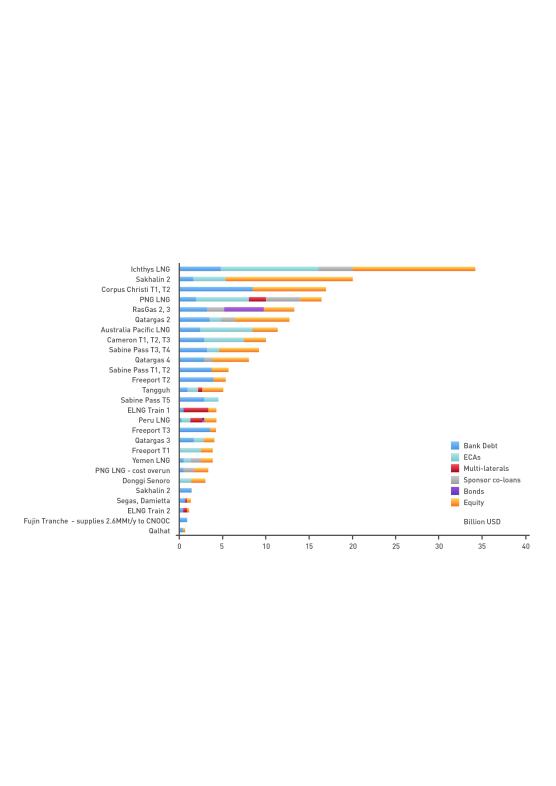
01 POWER ISLAND / 01 CCPP / DOE__Understanding Natural Gas and Lng Options October 11 2017_1
.pdf
FINANCING AN LNG EXPORT PROJECT
Banks will assess the risk of lending to a project and if they decide to go ahead, they will approach their credit committees to get approval. Banks have their own internal rating systems for countries and this will be applied, but a decision to lend to the project is based on a consideration of all of the project's characteristics. They will determine whether the project structure and the project financing are sufficiently robust. They will take a view on the ability of the EPC contractors and project sponsors to implement the project.
Of special significance to the lenders are the offtake or tolling agreements. These need to be of sufficient duration to allow the debt to be serviced across long repayment horizons. They also need to be with creditworthy counterparties. Banks do not want exposure to market risk. Decisions are made by banks whether to fund projects on a case-by-case basis as no two projects are alike.
A critical element of a lender's assessment of the project will include thorough legal due diligence to determine whether there is any fatal problem with the project that could jeopardize the project company's ability to make debt service payments. The scope of legal due diligence should be tailored to the characteristics of each project, but typically will include:
>An analysis of the laws of the host country.
>A contractual alignment review to ensure that the major project agreements have consistent provisions and do not contain any unintended contractual disconnects.
>A review of the project company's permits and licenses to ensure that they are adequate to construct, own and operate the liquefaction project and were obtained in compliance with all applicable laws.
>An analysis of the project company's real and personal property rights.
The finance documents, including the mortgage and security documents, will also be carefully reviewed and commented upon by the project lenders and their respective counsel.
Banks will reach a consensus price for the project, expressed in basis points over the London interbank offered rate. Banks also receive other fees for participation, such as up-front fees and commitment fees.
166

FINANCING AN LNG EXPORT PROJECT
When a sufficient number of banks have received credit approval, the financing agreement or term sheet can be signed and the project can move to financial close and the drawdown of funds can begin.
The banks can provide financing as part of a club deal, or there can be a syndication process where a few banks agree to provide funding to the project. They then syndicate this to a wider group of banks. Debt is paid back to the lenders from the project earnings. The loans may be refinanced or repriced to take account of changing market conditions if agreed by the project company and lenders.
167

FINANCING AN LNG EXPORT PROJECT
Available Funding Sources
LNG projects raise funding from a variety of private and public funding sources as illustrated in the following diagram:
Source: Poten & Partners LNG Finance in World Markets, LNG in World Markets, published company reports.
168

FINANCING AN LNG EXPORT PROJECT
International commercial banks
Commercial banks have historically been the main providers of funding to liquefaction projects. As projects grew in size due to the need for economies of scale, and thus became more expensive to construct, banks were unable to provide all of the debt required. As a result, more funding sources were tapped. The need for access to other types of funding also became more urgent in the immediate aftermath of the 2008-09 global financial crisis as banks became more constrained due to their increasing internal funding costs. Initially, the problem was the erosion of confidence in banking counterparties - banks stopped lending to each other. Thereafter, constraints arose as a result of tightening legislation enacted to prevent a repetition of the events that triggered the crisis.
The implementation of stricter guidelines has continued. For example, under so-called Basel III guidelines, which are to come into full force by the end of the first quarter of 2019, banks are directed to apply more capital to long-term loans. Project finance loans fall into this category because their tenor typically extends out beyond the Basel III threshold. This is much longer than corporate loans. And it appears that successive revisions of the guidelines, which are published by the Bank of International Settlements, could require the application of more capital against long-tenored loans and loans that are assessed as being of higher risk. A wide range of international commercial banks will invest in LNG project finance transactions, although globally dominant players tend to come from Europe and Asia. But in LNG project finance it is not uncommon to have over 20 banks from several countries lending to a project. Increasingly, banks are selective and will make a decision on whether to provide loans based on whether they see the borrower as a key client who could possibly provide them with further business in the future or ancillary business related to the transaction, such as foreign exchange and interest rate hedging.
International commercial banks will typically provide loans to liquefaction projects in dollars because LNG cargoes are priced in dollars. This minimizes exposure of both lenders and the project entity to foreign exchange risk.
169

FINANCING AN LNG EXPORT PROJECT
A bank will determine the risk of a project based on its own internally determined country classifications, but it will also take into account many other characteristics of that project. The project will possibly have a lower risk than the country in which it sits if it is being implemented by creditworthy sponsors, has brought in an experienced engineering, procurement and construction contractor, and, crucially, if it has long term offtake or tolling contractors with creditworthy counterparties.
Domestic banks
Domestic banks can be a lot smaller than the international commercial banks which appear frequently on global LNG project finance transactions. They may also have limited access to dollars. However, in some project finance transactions, a separate tranche of loans can be provided in the local currency to allow local lenders to supply funding to the project.
Islamic banks
These banks are governed by Shari'a law and can also provide funding to LNG projects. But this would also be in a separate tranche, which would
have its own Shari'a compliant structure. However, it would still sit within the debt side of the project financing structure. Islamic banks are mostly, but not exclusively, tapped for funding in countries where common law is Shari'a-based.
170

FINANCING AN LNG EXPORT PROJECT
Export credit agencies
Export credit agencies (ECAs) became important providers of funding as liquefaction projects grew in size and cost and more sources of funding were required. But after the global financial crisis (see international commercial banks above) they took on an even greater role. ECAs are bilateral lenders and their primary role is to support exports from their host countries. Most of the ECAs supporting projects are from OECD countries. They will be able to participate in a project financing if the project includes content from their host countries. Local content can include equipment, services, expertise and equity participation. They broadly follow similar rules in assessing whether to provide funding and at what level of pricing. The minimum pricing level for all ECAs is determined by looking at commercial interest reference rates and country risk classifications, which are published by the OECD. However, ECAs will also apply discretion when looking at projects. Each project will be assessed on a case-by-case basis. So if the country risk classification is of a certain level, but the project features strong sponsors, engineering, procurement and construction contractors, and most importantly, long-term offtake or tolling by creditworthy companies, the project will have a higher rating than the country in which it sits.
ECAs can support a project in a number of ways. They can provide direct loans, but they can also provide commercial and political risk cover (sometimes up to 100%) for loans to which the banks supply the underlying funding. For loans that are covered by ECAs, the risk to banks then becomes that of the ECA's host country rather than the risk of the country in which the project is located. This has important ramifications for the pricing of the loan since it would be priced based on the ECA's own country credit risk. It should be noted that most ECAs that participate on LNG projects are from OECD countries with high credit ratings. Banks will have to apply less capital, under banking guidelines, to higher rated loans and so ECA cover can help attract more banks to the deal.
ECAs have provided a considerable amount of funding to LNG projects. The Export-Import Bank of the U.S., for example, provided almost $10 billion in direct loans to seven liquefaction projectsbetween 2003 and 2015. These comprise Nigeria LNG, Qatargas II and Qatargas III, Peru LNG, Papua New Guinea LNG, and Australia's Australia Pacific LNG and Queensland Curtis LNG. Most of this was provided to projects that were using project finance structures, with the exception of QC LNG.
171

FINANCING AN LNG EXPORT PROJECT
The Japanese Bank for International Cooperation has been a big supporter of LNG projects. Japan is natural resource poor and as it has sought access to LNG, its domestic utilities have participated as offtakers (customers) or tolling counterparties or as EPC contractors on projects. For example, JBIC provided a direct loan of $2.5 billion to the Cameroon LNG project and sister agency, Nippon Export and Investment Insurance also provided $1.57 billion of cover to the project. China's ECA, Export-Import Bank of China (China Exim) is increasingly providing funds and cover to LNG projects. China Exim and China Development Bank agreed to provide direct loans of€9.3 billion ($10.54 billion) and RMB 9.8 billion ($1.51 billion) in April 2016 to Russia's Arctic 16.5MMt/y Yamal LNG project. As a result of sanctions implemented against Russia by the EU and U.S., this is one of the few LNG project financing transactions to receive loans in currencies other than dollars.
Given the large amounts of both cover and funding that can be provided by ECAs, the desire to unlock that support can drive the selection of EPC contractors.
Development Banks
Some development banks come in early to structure projects - such as the IFC, the African Development Bank or the EIB. Their roles can include equity participation, due diligence, benchmarking against international best practices (using thorough social and environmental safeguards), lending and syndication, as well as offering risk coverage guarantees. In addition, because development banks usually have long-standing relationships with host governments in Africa, which may include access to lawmakers and government officials, their participation in the project can provide added confidence to lenders as a risk mitigation factor.
172

FINANCING AN LNG EXPORT PROJECT
The World Bank Group negative pledge clause
When providing loans for infrastructure development projects, instead of taking a lien over the state’s assets, the World Bank protects its interests via a broadly-worded negative pledge clause. This clause ensures that any lien created on any public assets as security for external debt that results in a priority for a third-party creditor will also secure all amounts payable by the borrowing state. In short, should such a lien be granted, the World Bank shares in the amounts paid out to the third-party creditor, thus preventing the creditor from enjoying senior creditor status and undermining the value of any later granted lien. As a consequence, the clause undermines the state’s ability to engage with other creditors and can end up preventing the state from attracting commercial investment for project financing. This needs to be carefully examined when considering raising debt from the World Bank Group, given the cons might outweigh the pros in assembling the overall debt package for the project.
Sponsor co-loans
These can be tapped for large projects where the funding needs are considerable. Sponsors, in this case, act as debt providers and receive a margin payment for their loans in the same manner as banks. They typically rank pari passu, on equal footing, with the other debt providers.
Other providers, debt, and equity
Projects can also raise financing via other means, although these are less common. They can issue bonds, which can sit within the debt side of the project finance structure and rank on an equal footing with other lenders in terms of payback. However, bond investors do not relish construction risk exposure, so bonds are often offered post-construction and are mostly used to refinance bank debt. To issue project bonds, project sponsors will employ a bank or group of banks as book runners. They will promote the project via a 'roadshow' to countries where they expect investor appetite for the project will be strong.
173

FINANCING AN LNG EXPORT PROJECT
Private equity companies and pension funds are also stepping up participation on LNG projects. Project sponsors can also raise equity for the project through share offers, although thus far this activity in LNG is prevalent mostly in the U.S..
174

FINANCING AN LNG EXPORT PROJECT
Impact of Market Shifts on Project Finance
The global LNG industry is undergoing a transformation as technological advances are uncovering massive new gas reserves. LNG infrastructure is changing rapidly with the advent of new technologies, natural gas prices are becoming increasingly decoupled from oil prices, and U.S. LNG exports are introducing new flexibility into global LNG marketing and trading. The number and type of LNG market participants have increased dramatically as lower prices make imports more affordable, with floating storage and regasification units also facilitating the opening of new markets. Short term and spot LNG transactions are making up a greater portion of global LNG trade. The current LNG supply imbalance and low oil price environment have also put downward pressure on global LNG prices.
These changes are impacting LNG project finance. Liquefaction projects are less likely to be structured as point-to-point integrated projects with dedicated shipping where the credit of an investment-grade utility buyer provides the financial underpinning for the entire LNG value chain through a long-term take-or-pay LNG SPA indexed to oil prices. LNG project finance in the wake of this market shift will require innovative structuring and project agreements. Tolling structures with creditworthy tolling customers will likely continue to be used to allocate LNG market risks away from LNG project company borrowers. With respect to integrated and merchant structures, although long-term LNG SPAs will likely continue to be required in spite of the growth of short-term and spot LNG trade and price reopener provisions, international oil companies and LNG aggregators and trading companies are developing shipping and portfolio capabilities that may provide solutions to project lenders.
175
